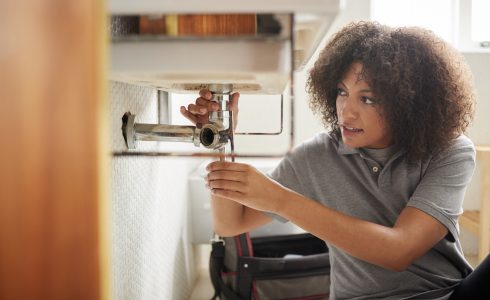
Homeownership is a rewarding experience but comes with its fair share of responsibilities. Regular home maintenance is important for preserving your investment and ensuring the safety and comfort of your living space. Whether you’re a new homeowner or have been in your house for years, knowing how to perform essential maintenance tasks can save you time and money in the long run.
Here are the essential home maintenance tasks that every homeowner should know how to do. By mastering these tasks, you can save significant costs and avoid future headaches.
The Importance of Home Maintenance
Owning a home is a milestone, but along with the joy of having your own space comes the responsibility of maintaining it. Regular home maintenance keeps your house in optimal condition, preventing minor issues from becoming costly repairs. Neglecting these tasks can lead to more significant problems, affecting your home’s structural integrity and value.
General Home Tasks
Shutting off the Main Water Supply: Knowing how to shut off your home’s main water supply is one of the most critical skills every homeowner should have. In case of a plumbing emergency, such as a burst pipe or a major leak, quickly turning off the water can prevent extensive water damage.
To turn off the main water shut-off valve, usually found near the perimeter of your house, simply turn the valve clockwise to stop the water flow. It’s a good idea to practice this task periodically to ensure you’re prepared in an emergency.
Resetting a Tripped Breaker: Electrical issues can be daunting, but resetting a tripped breaker is a simple task that can save you from unnecessary electrician visits. When a breaker trips, it cuts off the power supply to a specific circuit to prevent electrical overload.
Find your electrical panel, usually located in the garage or utility room. Open the panel and look for the breaker that has shifted to the “off” position or halfway between “on” and “off.” Flip it back to “on” to restore power to the affected area. Always exercise caution when dealing with electricity.
Checking and Maintaining Your HVAC System: Regular HVAC maintenance ensures your heating and cooling systems run efficiently, saving you money on energy bills and extending the lifespan of your equipment. Start by changing the air filters every 1-3 months, depending on usage and the type of filter. Dirty filters restrict airflow and reduce system efficiency.
Next, clean the condenser coils on your outdoor unit. Turn off the power, remove any debris, and use a garden hose to gently wash the coils. Schedule professional inspections twice a year—once before summer and once before winter—to identify potential issues early.
Patching a Hole in Drywall: Accidents happen, and small holes in your drywall can be easily fixed. Small holes from nails or screws or dings can be filled with a quick-drying spackle and sanded smooth before repainting. Larger holes will require a patch kit that can be purchased at the hardware store.
Holes larger than 1 square foot need additional work. Begin by cleaning the area around the hole and using a utility knife to cut a clean, square section around it. Cut a new piece of drywall to fit the hole and secure it with drywall screws. Apply joint compound over the seams and smooth it out with a putty knife. Once dry, sand it smooth and apply another layer if needed. Finally, prime and paint the patched area to match the rest of the wall.
Replacing Outlet Covers: Outlet covers can become worn or damaged over time. To replace them, turn off the power to the outlet at the breaker box. Remove the screw holding the old cover in place, then attach the new cover with the provided screw. This quick and easy task can instantly freshen up the look of a room.
Repairing or Replacing Window Screens: Damaged window screens can invite pests and reduce your home’s energy efficiency. Start by removing the screen frame from the window. Use a spline tool to remove the old spline, a rubber cord that holds the screen in place. Remove the damaged screen mesh. Lay the new screen mesh over the frame, and use the spline tool to press the new spline into the grooves, securing the mesh. Trim any excess mesh around the edges, and reinstall the frame.
Finding a Wall Stud: Locating wall studs is important for hanging heavy items like shelves, TVs, or artwork. An electronic stud finder simplifies this task. Turn on the stud finder and run it along the wall; it will beep or light up when it detects a stud.
If you don’t have a stud finder, use a measuring tape. Most studs are spaced 16 or 24 inches apart. Tap the wall lightly with a hammer; a solid sound indicates a stud, while a hollow sound means you’re between studs.
Kitchen Maintenance Tips
Fixing a Leaky Faucet: A dripping faucet can waste a significant amount of water and increase your utility bills. Begin by turning off the water supply to the faucet. Remove the faucet handle, usually held in place by a screw under a decorative cap. Next, use a wrench to remove the packing nut and the stem. Inspect the O-ring and washer for signs of wear and replace them if necessary. Reassemble the faucet and turn the water supply back on to check for leaks.
Cleaning the Dishwasher: Regular dishwasher maintenance ensures it runs efficiently and keeps your dishes sparkling clean. Start by removing the bottom rack and inspecting the drain for debris. Clean the filter if your dishwasher has one. Place a cup of white vinegar in a dishwasher-safe container on the top rack and run a hot water cycle to remove buildup. To eliminate odors, sprinkle baking soda on the bottom of the dishwasher and run a short hot water cycle.
Cleaning the Garbage Disposal: A clean garbage disposal prevents unpleasant odors and keeps your kitchen smelling fresh. Turn off the disposal and use tongs to remove any large debris. Pour a mixture of baking soda and vinegar down the drain, followed by boiling water, to break down buildup. Finally, grind ice cubes and citrus peels to freshen the disposal and sharpen the blades.
Bathroom Maintenance Tips
Unclogging a Sink or Drain: Clogged drains are a common issue in bathrooms. To unclog a sink or drain, start by removing any visible debris. Use a plunger to create suction and dislodge the clog. If that doesn’t work, remove the sink trap (the U-shaped pipe) under the sink and clean out any debris.
For stubborn clogs, try a drain snake to break up and remove the blockage. Avoid using chemical drain cleaners, as they can damage your pipes. Regularly cleaning your drains can prevent clogs and keep your plumbing in good working order.
Stopping a Running Toilet: A running toilet can waste a significant amount of water. To fix it, start by checking the flapper valve in the tank. If it’s worn or damaged, replace it with a new one. Adjust the fill valve to ensure the water level is correct. If the problem persists, consider replacing the entire flush mechanism. Addressing this issue promptly will conserve water and reduce your utility bills.
Re-Caulking the Bathroom: Over time, caulk can deteriorate and allow moisture to seep into your bathroom, causing mold and mildew. To re-caulk, remove the old caulk with a utility knife and clean the area thoroughly. Apply a new bead of caulk along the seams, smoothing it with your finger or a caulking tool. Allow it to dry completely before using the shower or tub. This simple task will keep your bathroom looking fresh and prevent water damage.
Laundry Room Maintenance Tips
Cleaning a Dryer Vent: A clogged dryer vent can be a fire hazard and reduce the efficiency of your dryer. Disconnect the dryer from the power source and remove the vent hose. Use a vent brush to clean out the lint and debris from the hose and the vent opening. Reattach the hose and plug the dryer back in. Regularly cleaning the dryer vent will improve performance and reduce the risk of fire.
Exterior Home Maintenance Tips
Cleaning Gutters and Downspouts: Clean gutters and downspouts ensure proper drainage and prevent water damage to your home. Use a ladder to access the gutters and remove any leaves, debris, and dirt. Flush the downspouts with a garden hose to clear any blockages. Regularly cleaning your gutters will protect your home’s foundation and prevent costly repairs.
Knowing When to DIY vs. Calling Professionals
While many home maintenance tasks can be handled by homeowners, some require professional expertise. Know your limits and recognize when it’s best to call in a pro. For example, electrical work or major plumbing repairs should always be left to licensed professionals to ensure safety and proper execution. On the other hand, tasks like changing air filters or cleaning gutters are manageable for most homeowners. Assess the complexity of the job and your skill level before deciding whether to DIY or hire a professional.
Regular home maintenance is essential for keeping your property in top condition and preventing costly repairs. By mastering these essential maintenance tasks, you’ll save money, improve your home’s safety, and enhance its overall value. Don’t wait for problems to arise; stay proactive and tackle these maintenance tasks head-on.
Remember, if you’re unsure about a task or feel overwhelmed, don’t hesitate to seek professional help. Taking care of your home is an ongoing process, and with the right approach, you’ll enjoy a well-maintained and beautiful living space for years to come.
Are you looking for a new home in the Central Valley? FCB Homes builds new home communities in Lodi and Riverbank. Visit us online at FCBHomes.com to learn more about our new construction homes and find your new home.
